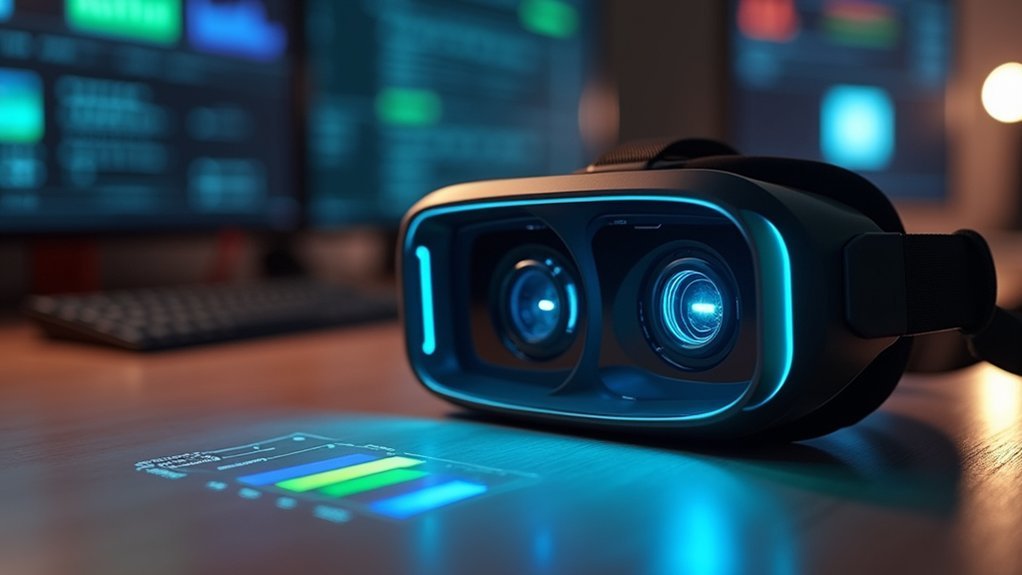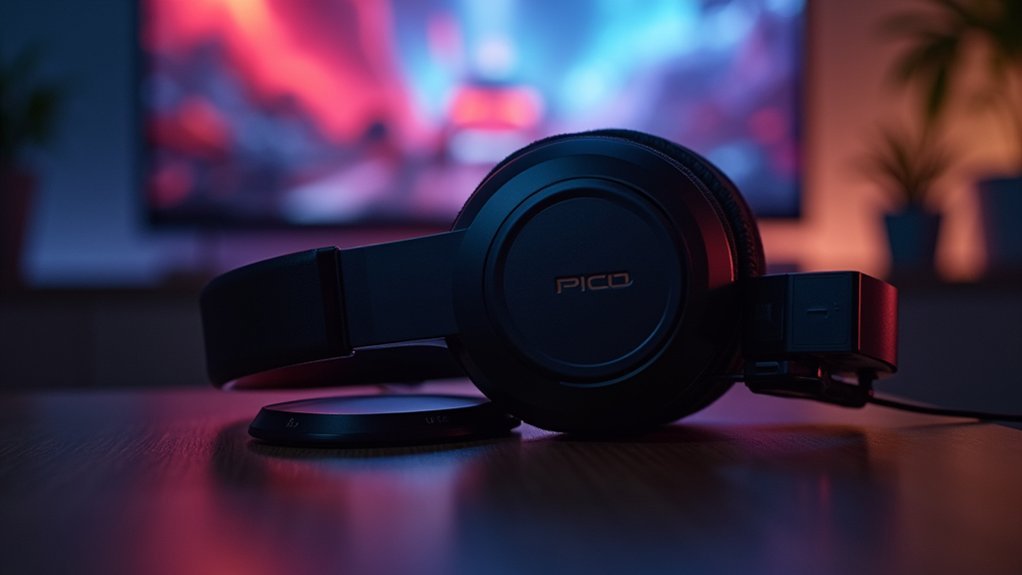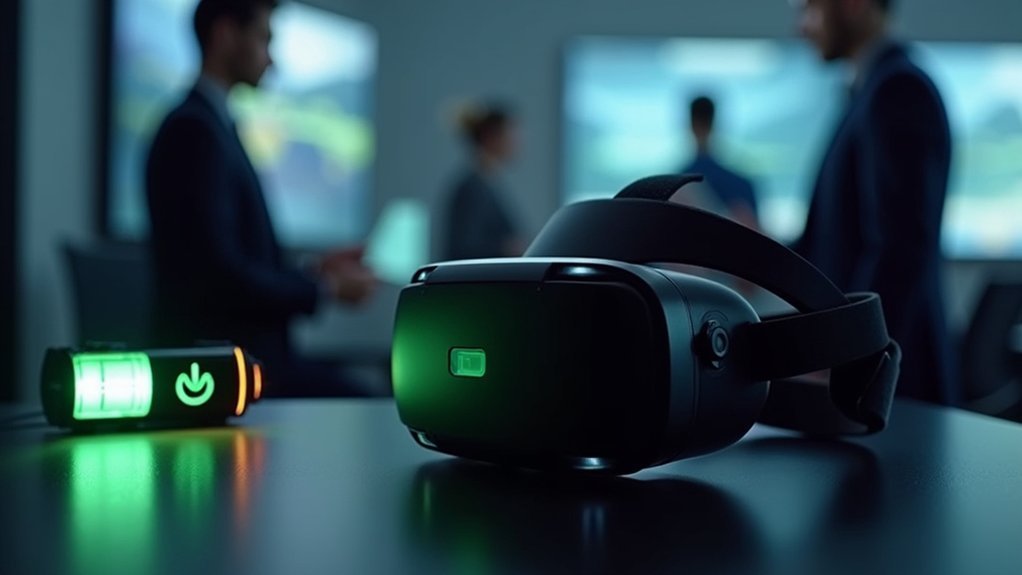You’ll find that battery life dramatically separates entry-level from professional VR experiences, with HTC Vive Focus Vision leading at 6 hours for enterprise use, while Pico 4 Ultra and Pico 4 deliver 3-4 hours for extended gaming sessions. Meta Quest 3, Quest 3S, and Quest Pro offer solid 2-3 hour performance, while Quest 2 remains a reliable benchmark. Apple Vision Pro’s 2-hour limitation requires external batteries, and HTC Vive Flow prioritizes portability over endurance—continue exploring to discover which headset matches your specific usage patterns.
Meta Quest 3: Premium Standalone Power Performance

While most standalone VR headsets compromise on visual quality, the Meta Quest 3 delivers exceptional performance with its high-resolution display of 2,064 by 2,208 pixels per eye and powerful processor. You’ll experience crisp visuals that make this standalone VR headset stand out from competitors.
However, you’ll need to manage your gaming sessions carefully since the battery life lasts approximately 2 hours per charge. The device excels in mixed reality applications thanks to its color pass-through capabilities, expanding your VR possibilities beyond traditional gaming.
At $499.99, you’re investing in a premium option that balances performance with value. The comfortable design guarantees you won’t experience discomfort during those intense gaming sessions, making it worth considering despite the battery limitations.
Meta Quest 3S: Budget-Friendly Battery Excellence
If premium performance stretches your budget, the Meta Quest 3S offers an attractive alternative at $299 that doesn’t sacrifice essential features. This budget-friendly VR headset delivers impressive 2-3 hour battery life sessions, letting you enjoy extended gaming without interruption.
You’ll appreciate the powerful processor that maximizes energy efficiency while maintaining smooth performance throughout your playtime. The high-resolution display produces crisp 2,064 x 2,208 pixels per eye, ensuring immersive visuals that won’t drain your battery excessively.
You’ll also benefit from integrated color pass-through cameras that enhance mixed reality experiences without greatly impacting power consumption. For newcomers and casual users seeking accessible VR technology, the Meta Quest 3S proves that budget-friendly doesn’t mean compromising on battery excellence or essential functionality.
Pico 4 Ultra: Extended Gaming Sessions Without Compromise

If you’re seeking a VR headset that won’t leave you tethered to a charging cable, the Pico 4 Ultra delivers exceptional battery performance for marathon gaming sessions.
You’ll experience truly uninterrupted VR gaming thanks to its extended power capacity that supports hours of immersive gameplay without frequent charging breaks.
This robust battery life means you can focus entirely on your virtual adventures rather than constantly monitoring power levels.
Battery Life Performance
When you’re deep into an immersive VR adventure, nothing breaks the spell quite like a dead battery warning flashing across your display. The Pico 4 Ultra’s exceptional battery life guarantees you won’t face this frustration during extended gaming sessions.
This standalone headset delivers hours of uninterrupted gameplay on a single charge, thanks to its optimized battery performance that’s specifically engineered for demanding VR experiences.
You’ll appreciate how the headset maintains high-quality visuals at 2160 x 2160 per eye throughout your entire session, with no performance degradation as the battery depletes.
Combined with 12GB of RAM and 256GB of storage, you can enjoy intensive games without compromise. The lightweight design with built-in anti-fogging fan complements the impressive battery endurance, letting you game comfortably for hours.
Uninterrupted VR Gaming
The Pico 4 Ultra transforms your VR gaming routine by eliminating the constraints that typically force players to take unwanted breaks. This standalone headset delivers extended battery life that supports marathon gaming sessions, letting you dive deep into immersive experiences without worrying about power depletion.
You’ll enjoy stunning visuals through its 2160 x 2160 per eye resolution during these prolonged sessions, while the lightweight design and built-in fan prevent discomfort that typically interrupts gameplay.
The headset’s 256GB storage and 12GB RAM guarantee your gaming experience remains smooth across multiple titles. Since it operates as a fully standalone device, you won’t deal with tangled cables or external equipment that could disrupt your uninterrupted gaming flow, making extended play sessions truly seamless.
Meta Quest Pro: Professional VR With Comfort-Focused Battery Design
Although battery life remains a consideration at 2-3 hours per charge, Meta’s Quest Pro delivers professional-grade VR performance that prioritizes user comfort during extended sessions. You’ll appreciate the 1800×1920 per-eye resolution and 106-degree field of view that create immersive high-quality VR experiences for professional applications.
The comfort-focused design features a cushioned headband that reduces fatigue during prolonged use. Advanced hand-tracking technology enhances interaction while minimizing controller dependency, improving overall comfort. While the battery life is shorter than competitors, it’s strategically designed for focused work sessions.
| Feature | Specification | Benefit |
|---|---|---|
| Resolution | 1800×1920 per eye | Crystal-clear visuals |
| Field of View | 106 degrees | Immersive experience |
| Battery Life | 2-3 hours | Focused sessions |
| Hand Tracking | Advanced technology | Enhanced comfort |
| Design | Professional grade | Extended usability |
HTC Vive Focus Vision: Enterprise-Grade Standalone Endurance

When you’re running enterprise VR operations, the HTC Vive Focus Vision’s 6-hour battery life guarantees you won’t interrupt critical training sessions or industrial simulations mid-workflow.
You’ll find its power management system specifically engineered for demanding business applications that require sustained performance without the thermal throttling common in consumer headsets.
The headset’s enterprise-grade endurance translates to measurable productivity gains when you’re deploying VR across manufacturing floors, medical training facilities, or architectural review sessions.
Battery Life Performance
Since enterprise environments demand extended operational periods without interruption, HTC’s Vive Focus Vision delivers an impressive 6-hour battery life that sets it apart from consumer-focused alternatives.
This standalone device leverages the Qualcomm Snapdragon XR2 processor’s efficient power management to maintain high-quality visuals throughout your workday without compromising performance.
You’ll appreciate how the headset balances processing power with energy consumption, ensuring productive sessions across various professional applications.
When you do need to recharge, the rapid charging capabilities minimize downtime between uses, which proves essential in busy business environments.
The combination of extended battery life and quick charging means you won’t experience frequent workflow interruptions.
This reliability makes the Vive Focus Vision particularly valuable for training sessions, design reviews, and collaborative projects where consistent performance matters most.
Enterprise Usage Scenarios
While traditional VR headsets struggle with the demanding requirements of corporate environments, the HTC Vive Focus Vision transforms how enterprises approach immersive technology deployment.
You’ll experience 4K per eye through its high-resolution display, delivering exceptional clarity for training simulations and presentations. The headset’s standalone nature eliminates complex setup procedures, letting you deploy quickly across multiple locations without external hardware dependencies.
Your training sessions benefit from accurate motion detection through advanced tracking technology, essential for immersive enterprise applications ranging from medical simulations to engineering walkthroughs.
The robust battery life supports extended corporate usage without interruptions, while thorough enterprise software compatibility guarantees seamless integration with existing workflows.
You can confidently implement collaborative projects knowing this headset handles demanding professional applications with reliable performance.
Power Management Features
Powering through demanding enterprise applications requires more than just cutting-edge display technology—it demands intelligent energy management that keeps pace with your workflow demands.
The HTC Vive Focus Vision delivers exceptional battery life with up to 6 hours of continuous operation, perfect for extended training sessions and professional presentations.
You’ll appreciate the smart power-saving modes that automatically optimize performance based on your current application needs. When you’re not running high-demand software, the headset conserves energy intelligently.
The lightweight design guarantees comfort during prolonged enterprise use without compromising power efficiency.
Quick charging technology becomes your productivity ally, letting you rapidly recharge during brief breaks.
This thorough power management system keeps your VR sessions uninterrupted, making the Focus Vision ideal for serious enterprise applications.
Apple Vision Pro: Mixed Reality Battery Innovation and Limitations
Although Apple engineered the Vision Pro with cutting-edge mixed reality capabilities, the headset’s two-hour battery life presents a significant trade-off for users seeking extended immersive experiences.
The Apple Vision Pro’s demanding processing requirements, driven by dual micro-OLED displays delivering 4K resolution per eye, necessitate an external battery solution that you’ll need to manage carefully during use.
You’ll appreciate Apple’s focus on comfort and design, incorporating premium aluminum and carbon fiber materials while maintaining wireless operation for enhanced mobility.
However, the battery life limitation becomes critical when you’re engaged in intensive mixed reality applications.
The external battery pack design allows you to continue using the headset while plugged in, but this dependency on power management ultimately constrains your freedom during extended sessions.
Pico 4: Balanced Performance and Power Efficiency
The Pico 4 addresses many battery life concerns that plague premium headsets by delivering 3 to 4 hours of continuous use while maintaining impressive visual quality. You’ll appreciate its 2160 x 2160 per eye resolution that creates an immersive visual experience without sacrificing power efficiency. The lightweight design at just 295 grams guarantees comfort during extended sessions, while the built-in fan prevents fogging issues.
| Feature | Specification |
|---|---|
| Battery Life | 3-4 hours continuous |
| Weight | 295 grams |
| Resolution | 2160 x 2160 per eye |
| Cooling | Built-in fan system |
As a fully standalone device, you won’t need external equipment or high-end PCs. This makes the Pico 4 perfect for casual gaming while balancing performance and power consumption effectively.
Meta Quest 2: Legacy Standalone Battery Benchmark
Meta Quest 2 established itself as a battery life benchmark when it launched, delivering 2 to 3 hours of continuous gameplay that set expectations for standalone VR devices.
You’ll find this duration adequate for most sessions, though intensive applications and high graphic settings will drain power faster.
The headset’s USB-C port enables quick recharging between gaming sessions, minimizing downtime.
If you need extended playtime, the optional Elite Strap with built-in battery adds 2 to 4 hours of additional power.
At 503 grams, the Meta Quest 2 balances weight with decent battery performance for a standalone device that doesn’t require PC tethering.
This combination of portability and power efficiency helped establish the standard other manufacturers would later follow.
HTC Vive Flow: Lightweight Design With Power Trade-Offs
You’ll find the HTC Vive Flow takes a drastically different approach than the Meta Quest 2, prioritizing extreme portability at just 189 grams with its unique folding design.
However, you’re trading raw performance for that ultra-lightweight build quality, as the headset can’t match higher-end standalone devices in processing power.
The most significant compromise you’ll encounter is the 2-3 hour battery life, which severely limits extended VR sessions compared to its competitors.
Ultra-Portable Build Quality
At just 189 grams, HTC’s Vive Flow represents a radical departure from traditional VR headset design, prioritizing extreme portability over raw performance. You’ll appreciate the ultra-portable build quality when you’re slipping this compact design into your bag or even a large pocket. The lightweight design makes extended sessions comfortable, though you’ll notice trade-offs in visual fidelity with its 1600 x 1600 per eye resolution.
| Feature | Specification |
|---|---|
| Weight | 189 grams |
| Battery Life | ~5 hours |
| Resolution | 1600 x 1600 per eye |
The external battery affects true portability, and you’ll find standalone capabilities limited by smartphone dependency. Despite these compromises, the Vive Flow delivers excellent mobility for casual VR experiences.
Battery Performance Compromises
While the Vive Flow’s 189-gram frame delivers exceptional portability, its 2,500 mAh battery capacity creates notable compromises in sustained usage.
You’ll experience approximately 4-6 hours of usage time, which varies based on application intensity. The lightweight design prioritizes comfort over battery performance, making it ideal for casual sessions but potentially limiting for extended VR marathons.
You’ll need to rely on USB-C charging during longer sessions, which constrains your freedom compared to headsets with more robust battery life.
While the portability makes setup effortless, demanding applications can drain power quickly, potentially interrupting immersive experiences.
The Vive Flow fundamentally trades battery endurance for its ultra-portable form factor, requiring you to balance convenience against extended usage needs when choosing this headset.
ByteDance Pico Neo 3: International Alternative Battery Analysis
Although the VR market continues to be dominated by Meta’s Quest series, ByteDance’s Pico Neo 3 offers a compelling international alternative with impressive battery specifications that deserve serious consideration.
You’ll get approximately 3 hours of battery life from its substantial 5,300 mAh built-in battery, matching competitive standards in standalone VR.
The Pico Neo 3’s power system delivers notable advantages:
- Fast charging capability reaching 80% capacity in just 2 hours
- Lightweight 300-gram design optimized for extended comfort during sessions
- Efficient power management balancing performance with consumption
- Adequate capacity for immersive gaming and extended experiences
- Minimal downtime between VR sessions due to quick recharge cycles
You’ll appreciate how the headset’s intelligent power management system maximizes your VR time while maintaining consistent performance throughout each session.
Frequently Asked Questions
What Is the Best Standalone VR Headset?
You’ll find the Meta Quest 3 is the best standalone VR headset, offering excellent 2,064 x 2,208 per-eye resolution, wireless convenience, and comfortable design without requiring external hardware connections.
What Is the Best Stand Alone VR Headset Reddit?
You’ll find Reddit users consistently recommend the Meta Quest 3 as the best standalone VR headset for its $499 price, high-resolution displays, and extensive game library compatibility.
What VR Headset Works by Itself?
You’ll find that standalone VR headsets like Meta Quest 3 and Quest 3S work independently without needing a PC or console. They’ve got built-in processors, tracking systems, and displays for complete self-contained experiences.
What Is the Battery Life of VR Headsets?
You’ll get 2-3 hours from Meta Quest 3 and Quest 3S headsets on full charges. Apple Vision Pro uses external battery packs, while tethered headsets draw power from connected devices for unlimited usage.





Leave a Reply